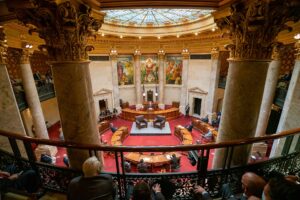| Contribute a translation | Source (English) |
|---|---|
Our Father who art in heaven, on earth, and all over the universe; hallowed by Thy name; Thy kingdom come with the dawn of creation; and being established upon principles universal and everlasting, its laws enforce themselves with equal force in all climes and in all generations. | |
Wherefore Thy will must be done in heaven, among the celestials, even as it is among the mortal sons of men on earth. | |
Thou hast made us the rulers of this mundane world, constraining nature’s subservience to our will, and by those means thou kindly givest us our daily bread, | |
while on the other hand, the imparting of thy divine spirit guides us in the enactment of laws to secure our social happiness, and deliver us from all evil. | |
For the performance of that sacred and high privilege, we are assembled before thee in this Sinai of our sovereign State. And as once the son of Amrom upon the smoke-enveloped peak of Horeb proclaimed humanity and justice to the constitutents of thy then chosen people, summoning down the lightnings from their native heavens, even so each of thy sons present is standing here in the capacity of a Moses, and may be thy will to imbue their minds with the flashes of thy wisdom, and grant them the visitations of thy divine spirit, so that while representing the will of the people, they may equally represent the will of thee who art our Father and Lord. |
This is a civic prayer for opening a legislative session that was re-published in The Republican Banner (Nashville, Tennessee) on 22 December 1872 under the title, “A New Version: The Lord’s Prayer with Variation.” The article introduces the prayer as follows: “The following prayer, rendered by the editor of The Jewish Independent of Louisville, at the opening of the Wisconsin Senate, February 15, 1872, appears in the Independent of last week.” The Jewish Independent was the paper of Rabbi Dr. Edward B.M. Browne (a/k/a Alphabet Browne). The year 1872 was likely mistaken for 1871, when according to the Journal of the Proceedings of the Wisconsin State Senate, Rabbi Browne offered the opening prayer on 14 February. The Wisconsin Senate opened its 1871 session with a resolution to inviting resident clergy to offer a prayer on each morning session. That was soon followed by an amendment requiring the guest chaplains to read the Lord’s Prayer. While that amendment failed, it likely inspired this prayer. (The following year, 1872, the option of inviting guest chaplains was rejected altogether, and the Wisconsin Senate voted for the President of the Senate, a Senator Irish, to offer the opening prayer instead.) Twenty-three years later, when invited to offer a prayer before the US Senate, Rabbi Browne delivered a prayer described by the Senate chaplain as “very unique, being the Lord’s Prayer with variations” (in “[Rabbi Browne, pastor of Temple Gates of Hope]” National Republican, 21 May 1884, p. 6). –Aharon Varady
Source(s)

““The Lord’s Prayer with Variations,” a civic prayer for opening a legislative session by Rabbi Dr. Edward B.M. Browne (14 February 1871)” is shared through the Open Siddur Project with a Creative Commons Public Domain Dedication 1.0 Universal license.








![prayer for the national fast day at the outbreak of the civil war [1861-09-26] (Sabato Morais Ledger, p. 21 clipping 022) - a](https://opensiddur.org/wp-content/uploads/2022/07/prayer-for-the-national-fast-day-at-the-outbreak-of-the-civil-war-1861-09-26-Sabato-Morais-Ledger-p.-21-clipping-022-a-250x250.jpg)



Leave a Reply